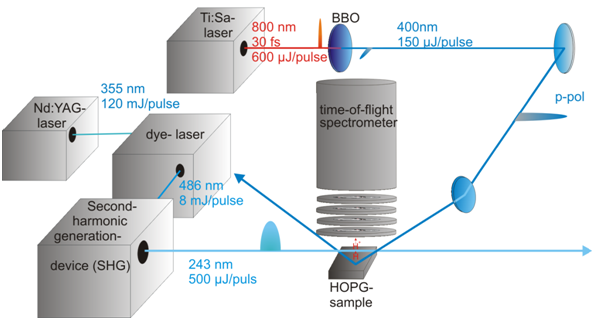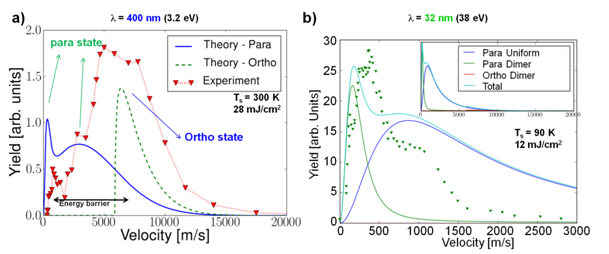Hydrogen desorption from graphite
In the interstellar medium (ISM) hydrogen clouds play an important role in protostar formation. These clouds consist of atomic and molecular hydrogen which convert into each other by different processes. This conversion is of great astrophysical interest. One possible way in which the reaction takes place is the molecular hydrogen formation on carbon dust particles induced by interstellar radiation.
In our laboratory we study the interaction between hydrogen and graphite in an ultra-high vacuum chamber as an idealized system to explore the mechanisms of the hydrogen conversion in the ISM. As radiation sources, we use different femtosecond laser systems. A frequency doubled Ti:Sa laser set-up at an photonenergy of 3 eV (400 nm) provides laser pulses of 30 femtosecond pulse duration with an average power of 150 mW and a repetition rate of 1 kHz. The set-up consists of an oscillator and two amplifiers to reach maximum performance energy of 5W at 1.5 eV.
The 3 eV photons enter the graphite surface, excite the electrons and a non-equilibrium “hot electron” distribution develops. These electrons relax by several scattering processes in the sample. Further, a excitation of the adsorbate-substrate bound is possible. After several processes forth and back between adsorbate and substrate the adsorbate acquired enough kinetic energy to desorb from the sample. This process is commonly described as DIMET (desorption Induced by multiple electron transition).
The neutral desorbed atoms are detected in a time-of-flight spectrometer. For the detection the atoms are ionized by a (2+1) resonant- enhanced- multi- photon- ionization- scheme (REMPI), providing a way to select only distinct atom spices. Therefore we use a frequency doubled tunable laser set-up, consisting of solid state Nd:YAG laser pumping a dye laser providing photon wavelength in the UV at 243 nm.

Fig. 1: Experimental set-up
At several beam times the whole experimental set-up has been transferred to Hamburg to use the free electron laser. Their photons in the X-ray regime can provide energies similar to the interstellar radiation.
As a result an arrival time distribution has been recorded by changing the time-delay between the desorption and the detection laser pulse. The arrival time can be transformed by a Jacobi-transformation into a flight time and afterwards a velocity distribution is derived (fig. 2). The red dots in figure 2 a represent the experimental data obtained from the 3.2 eV Ti:Sa laser while the graph in figure 2 b represents the data for the x-ray laser set-up at FLASH. The structures can be divided in different distributions with different mean velocities. For 32 nm there are three distribution with maximum velocities of 170 m/s, 1000 m/s and 6000 m/s while for 400 nm only two maximum velocities at 400 m/s and at 5700 m/s with a shoulder in between at 2700 m/s. Some of these distributions reveal extreme slow atomic velocities compared to the sample temperatures.
Electron scattering calculations have been performed employing a repulsive electronic state and the H-graphite adsorption potentials appropriate for different adsorption sites. Besides populating different vibrationally excited states in multiple scattering events, velocity distributions for desorption out of different adsorption sites are obtained. These ccalculations show a correlation between different adsorption arrangements on the graphite sample and the maxima in the velocity distributions [1,2]. While the different distributions for the lower desorption energy at 400 nm can be explained by different adsorption sites of hydrogen on graphite, for 32 nm there seems to be a further mechanism. To describe these data sufficiently the coverage has to be understood as two different types of hydrogen-clusters consisting of only para dimers (uniform-para-structure), and a mixture of para and ortho dimers as it is for the 400 nm data, respectively. These modifications in the calculation do not affect the data at 400 nm since the energy is several times lower compared to 32 nm.

Fig. 2: Velocity distribution of hydrogen desorption from graphite at 400 nm (a)[1] and 32 nm (b)[2]
As clearly can be seen this project is only at the beginning and several further step will follow. After some final measurements at the atomic desorption the set-up will be changed for molecular hydrogen detection, to go a further step in the understanding of the cycle of matter.
[1] R. Frigge et al. , Phys. Rev. Lett., 104, 256102 (2010)
[2] B. Siemer et al. , Chem. Phys. Lett., 500, 291 (2010)


